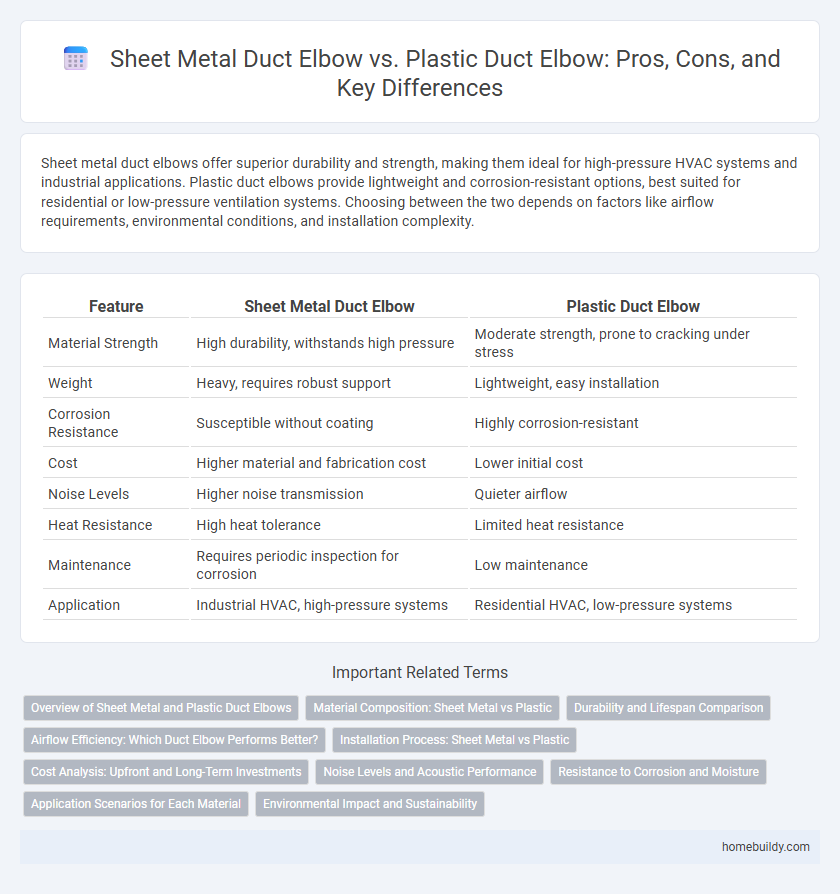Sheet metal duct elbows offer superior durability and strength, making them ideal for high-pressure HVAC systems and industrial applications. Plastic duct elbows provide lightweight and corrosion-resistant options, best suited for residential or low-pressure ventilation systems. Choosing between the two depends on factors like airflow requirements, environmental conditions, and installation complexity.
Table of Comparison
| Feature | Sheet Metal Duct Elbow | Plastic Duct Elbow |
|---|---|---|
| Material Strength | High durability, withstands high pressure | Moderate strength, prone to cracking under stress |
| Weight | Heavy, requires robust support | Lightweight, easy installation |
| Corrosion Resistance | Susceptible without coating | Highly corrosion-resistant |
| Cost | Higher material and fabrication cost | Lower initial cost |
| Noise Levels | Higher noise transmission | Quieter airflow |
| Heat Resistance | High heat tolerance | Limited heat resistance |
| Maintenance | Requires periodic inspection for corrosion | Low maintenance |
| Application | Industrial HVAC, high-pressure systems | Residential HVAC, low-pressure systems |
Overview of Sheet Metal and Plastic Duct Elbows
Sheet metal duct elbows provide superior durability and resistance to high temperatures, making them ideal for industrial HVAC systems requiring long-lasting performance. Plastic duct elbows offer lightweight construction and corrosion resistance, suitable for residential and low-pressure ventilation installations. Both types facilitate directional airflow changes, but sheet metal excels in structural strength while plastic ensures ease of installation and cost-effectiveness.
Material Composition: Sheet Metal vs Plastic
Sheet metal duct elbows are typically made from galvanized steel or aluminum, offering high durability, resistance to heat, and structural strength essential for commercial HVAC systems. Plastic duct elbows, commonly composed of PVC or ABS, provide lightweight flexibility and corrosion resistance but generally lack the mechanical robustness and temperature tolerance of metal counterparts. The choice between sheet metal and plastic duct elbows hinges on application requirements, balancing metal's long-lasting strength against plastic's ease of installation and resistance to moisture.
Durability and Lifespan Comparison
Sheet metal duct elbows exhibit superior durability compared to plastic duct elbows, withstanding higher temperatures and physical impact without deformation or cracking. Their lifespan often exceeds 20 years in industrial HVAC systems, while plastic duct elbows typically last around 10 to 15 years under similar conditions. The corrosion resistance of galvanized or stainless steel sheet metal further enhances long-term performance, making them ideal for demanding environments.
Airflow Efficiency: Which Duct Elbow Performs Better?
Sheet metal duct elbows offer superior airflow efficiency due to their smooth interior surfaces and precise fabrication, minimizing air resistance and turbulence. In contrast, plastic duct elbows may have rougher surfaces and less structural rigidity, potentially causing greater airflow friction and reduced performance. Projects demanding optimal ventilation often favor sheet metal elbows for enhanced durability and consistent air distribution.
Installation Process: Sheet Metal vs Plastic
Sheet metal duct elbows require precise cutting, bending, and sealing with metal fasteners or welds, making their installation more labor-intensive and time-consuming. Plastic duct elbows feature interlocking joints or snap-fit designs that simplify alignment and reduce the need for specialized tools, speeding up the installation process. The choice between sheet metal and plastic elbows impacts installation complexity, labor costs, and the need for skilled technicians.
Cost Analysis: Upfront and Long-Term Investments
Sheet metal duct elbows require higher upfront investment due to material and fabrication costs but offer superior durability and longevity, reducing long-term replacement expenses. Plastic duct elbows have lower initial costs and simpler installation but may incur higher maintenance and replacement costs over time due to susceptibility to damage and wear. Evaluating total cost of ownership, sheet metal proves more cost-effective for long-term HVAC system performance.
Noise Levels and Acoustic Performance
Sheet metal duct elbows typically generate higher noise levels due to airflow turbulence and vibration compared to plastic duct elbows, which offer superior acoustic performance by reducing sound transmission and dampening vibrations. The rigid nature of metal amplifies noise, whereas plastic materials absorb sound waves more effectively, making them ideal for noise-sensitive environments. Choosing plastic duct elbows enhances overall HVAC system quietness, contributing to improved occupant comfort.
Resistance to Corrosion and Moisture
Sheet metal duct elbows offer superior resistance to corrosion and moisture due to their durable metallic composition, often featuring galvanized or stainless steel that withstands harsh environmental conditions. Plastic duct elbows, while resistant to moisture, are more prone to degradation from prolonged exposure to UV rays and certain chemicals, limiting their effectiveness in corrosive environments. For applications involving high humidity or chemical exposure, sheet metal elbows provide enhanced longevity and structural integrity compared to plastic alternatives.
Application Scenarios for Each Material
Sheet metal duct elbows excel in commercial HVAC systems and industrial applications where durability and high temperature resistance are critical. Plastic duct elbows are ideal for residential ventilation and low-pressure air distribution, offering corrosion resistance and lightweight properties. Each material suits specific environments based on factors like airflow pressure, temperature, and exposure to chemicals.
Environmental Impact and Sustainability
Sheet metal duct elbows offer superior sustainability due to their recyclability and longer lifespan, reducing landfill waste compared to plastic duct elbows that often end up as non-biodegradable waste. The production of sheet metal involves fewer harmful chemicals and generates less environmental pollution than the manufacturing processes for plastic ducts, which rely heavily on petrochemicals. Choosing sheet metal duct elbows supports eco-friendly building practices by minimizing carbon footprint and promoting material reuse.
Sheet metal duct elbow vs plastic duct elbow Infographic

 homebuildy.com
homebuildy.com